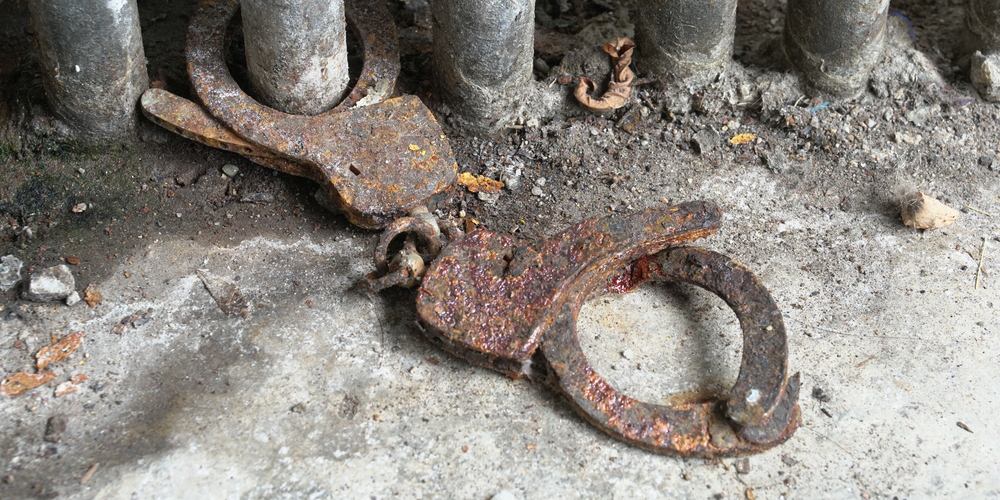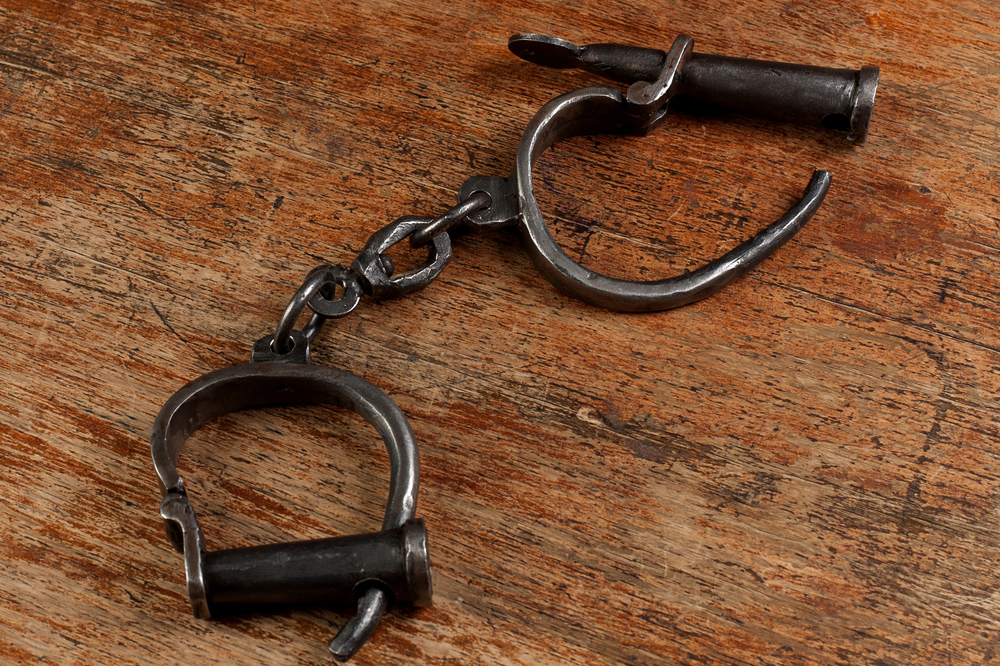Lock Blog
A resource for consumers, locksmiths, and security professionals
A resource for consumers, locksmiths, and security professionals

Before we get into the fascinating history of handcuffs, there are few things to take care of. Due to the use of these devices by law enforcement, it is of the utmost importance that we stress, all of this information is only intended for educational purposes. Any use of this information to evade law enforcement or commit illegal acts is not endorsed by United Locksmith or myself. Follow all of the laws in your area, and never try to escape police custody. With that said, let the learning begin.
Handcuffs are linked restraints intended to be worn on a person’s wrists. The intention of these devices is to restrict the movement of a prisoner or detained person. The restriction of movement limits the potential risk of escape, as climbing, running, and even using the doors is made more difficult. Handcuffs also lessen the risk of the handcuffed person successfully injuring anyone around them. Once handcuffs are placed on an individual, they become much easier to control. This has lead to widespread use across law enforcement agencies around the world.
Their usage has become so connected with criminality, that certain countries even have restrictions on depicting handcuffed people. France does not allow the media to show pictures of people handcuffed until they have been convicted in a court of law. Hong Kong police offer head coverings to anyone being handcuffed. And Japan goes as far as to blur out the person’s hands if they are wearing cuffs. The existence of blurred hands in a Japanese photograph may lead to some level of defamation of character, but all of these laws recognize the socialized understanding of what handcuffs mean.
The origin of the word ‘handcuff’ may seem pretty straightforward. Hand still means hand, and ‘cuff’ can mean the bottom of a sleeve. As handcuffs are most often placed on a person’s hands at approximately the cuff, the meaning of the word could simply stop there. But as most people with an interest in etymology know, the history of words is rarely so clear-cut.
The obvious connection between the cuff of a hand and a handcuff came later in the development of the word, which had been ‘handcop’. In old English, the word cop, sometimes referred to as cosp, meant to fetter or bond. Literally translating into something very similar to hand binding.
Cop is itself, a progression from the Latin word ‘capere’, meaning capture, seize, grab, etc. This word evolved with old French dialects into ‘capper’, which meant, seize. And this was later taken by the English as the word ‘cap’. ‘Cap’ at that time held the meaning, arrest.
You may also recognize the term ‘cop’ as a slang term for law enforcement officers. It is no coincidence that a ‘cop’ would use ‘handcops’, as the intention of law enforcement is to place criminals in bondage. It is actually through this meaning of ‘cop’ became slang for police. It is not, in fact, an acronym for ‘Citizen On Patrol’, or a reference to the copper badges or buttons used on older law enforcement uniforms. The full term ‘Copper’ is just to express that this is a person who ‘cops’.
Single Strand – This is the moving part of the handcuff, which allows the restraints to be tighter or looser. When the handcuffs are open, you can see that it has small serrations on the free end, and is attached to the rest of the cuffs by a small rivet on the other.
Double Strand – This part of the handcuff is part of the metal that holds the locking mechanism(s), and where the swivel or hinges attach. Specifically, the double strand refers to the gap in the metal, where the single stand can slip through. This gap gives the appearance of having two strands. The single strand rivet is also visible on the outside of the double strand, which cradles the single strand.
Teeth – When the handcuffs are open, you can find the teeth on the exposed end of the single strand. These arched serrations work as a ratcheting system, so that they slide past the locking pawl on the cuffs, tightening the cuffs, but unable to loosen. When the last tooth slides past the pawl, the cuffs will be unlocked, as there is no longer anything to grip.
Pawl – Until it is moved out of the way, this spring loaded locking device keeps the ratcheting mechanism from allowing the handcuffs to loosen. When the key is inserted into the lock, the pawl is lifted so that the handcuffs can be loosened. In order to open the handcuffs, the pawl must be moved up while the teeth are slid out. If the key is not being simultaneously turned while the single strand is being moved, the ratchet will not release.
Keyway – On almost every pair of handcuffs, you can find the keyhole resting on one of the flat sides of both cuffs. Often these keyways have a circular shape with a rectangular hole extending from one side. In many cases, there will be a metal cylinder shape in the middle of the hole to help align the key and make picking more difficult. The key will need to be inserted into both of the cuffs in order to release both mechanisms. In the case of a double locking pair of handcuffs, the keyway will be the largest of the holes.
Jaw – This is a deep groove in the single strand of the handcuff, which comes at the end of the teeth. Once a pair of handcuffs is tightened past the jaw, the single strand will effortlessly pass through the gap in the double strand. The Jaw can create some trouble for amateurs trying to shim the locking pawl, as the shim can sometimes hit the gap of the jaw and bend or break the shim.
Single Strand Rivet – This connects the single strand to the double stand, allowing the single stand to move. Without the hinged movement allowed by the rivet, there would be no way to open, close, or tighten the cuffs. If this rivet were to break, the cuffs would be useless, unless the double lock has been engaged.
Link – The connection between the handcuffs can be maintained with either a hinged mechanism or a chain. These create a bridge between the two locked cuffs, which limit the range of motion for the wearer. Hinged cuffs are more secure simply because they produce a greater restriction to movement, and have a higher amount of metal.
Swivel – With a pair of handcuffs linked together with a metal chain, it was very important that the chain was free moving. The swivel allows the chain to spin so that it is much harder to bind the metal. Once the chain is bound, the metal can be used to assist in creating greater torque, and break the metal.
Double Lock Hole/Pin – The double lock hole is used to engage a locking bar, which keeps the ratcheting mechanism from allowing the cuffs to tighten or loosen. These can either be holes or pins, but either way, a pin will be moved. In the case of the hole design, a small cylindrical protrusion on the back of the handcuff key is used to slide a pin to the side (giving the final appearance of an empty hole). The side pin design requires the pin to be depressed. These locks are disengaged by turning the key clockwise in the keyway before turning it counterclockwise to release the locking pawl.

Much like locks in general, it is hard to say exactly when in humans developed the concept of handcuffs. But this practice certainly began before the advent of the criminal justice system. It is widely theorized that the first manufactured hand restraints were made from the hide of animals, perhaps even predating the creation of rope. In areas with strong vines, which did not need to be woven together for strength, animal hide would not be necessary, though it was most likely still used.
Very little is known about the first metal worked hand restraints. Most of the information is simply formed by studying the technology that came after, as a way of filling in the knowledge around the gaps. It can be assumed that they were less advanced than those used by later civilizations, meaning that they were not resizable, and more closely resembled shackles. With less advanced metal working knowledge of the time, it would have been easier to force open the restraints. Malleability would have made it simpler to open the wrist holes of the devices and slip your hands out. Imperfections leading to brittle metal could have also allowed smashing attacks to split the device open.
During Greco-Punic Wars between the Greeks and the Carthaginians, starting in approximately 600 BC, the use of chains and iron bindings is widely documented. These handcuffs were used to shackle prisoners of war with the intention of later selling these individuals as slaves. These temporary bindings were incredibly important, as the sale of slaves taken by the empires paid for wars, expansion, and basic city maintenance.
It is said that chariots full of handcuffs would be brought to battlefields in anticipation of an overwhelming victory. These metal restraints were technically shackles, which were merely one-size fits all. A ‘U’ shaped piece of metal was placed around the wrist, and then a small metal bar would be placed to keep the device from falling off. This small bar would then be locked temporarily or stamped so that the cuffs could not be removed unless it was broken.
These devices are most notablely different from handcuffs, because of their one-size feature. There is no way to adjust the size of a shackle, which has already been made. In cases where the prisoner was too large, or too small, standard shackles would do no good. This was especially problematic because shackles were largely mass-produced, meaning there would not be a multitude of available sizes. Non-standard shackles would need to be made special, or time would be taken to rework existing shackles.
What we now think of as handcuffs have a documented history dated back all the way to around 70 BC in the writings of the poet Virgil. The poet is largely credited with the first written account of what are traditionally considered handcuffs. In the myth of Proteus, manacles were described as the only way to trap the shapeshifter. In fact, Virgil’s description of the mythical locking device comes much closer to modern handcuffs than the shackles and chains of previous accounts. The idea behind these restraints is that they could tighten and loosen depending on the form being taken. They could also be slipped on easily and were not cumbersome to carry. However, this design would not catch on for some time, as primitive forging and metalworking would not allow for mass production.
The next breakthrough in hand restraints came around 500 AD during the middle ages of Europe. Shackles began to take on the hinged design. What this allowed jailers to do is have a tighter fitting manacle with greater shielding to the locking mechanism. Instead of closing a ‘C’ or ‘U’ shaped device, these old fashion handcuffs could close around the wrist. This would allow for less space in the restraints, as they could close in a circle. There was also room for a hasp so that a padlock could be used to keep them closed. These were not adjustable, but they were paving the way to better fitting handcuffs with the implementation of the hinge.

It is at this point that we begin to see the implementation of hinges, standardization of keyed opening, and ratcheting for adjustable use. The hinged locking arm is the predecessor to the single and double strand, as this allowed the handcuffs to be self-contained, no longer requiring the use of a bar insert. The keys were commonly screw keys, requiring quite a bit of time to unlock and lock the manacles. These were not built for fast use.
The ratcheting was much better than the one size fits all restrictions of shackles, but it still could not fully secure prisoners that were too large or small. In order to lock, the hasp with the bored holes would need to slip over the first tooth of the ratcheting mechanism. But the teeth were much fewer, significantly larger, and more spread out than modern handcuffs, so the difference between loose and tight was pretty subtle. Also, the cuffs could not be opened by over extending the locking mechanism past the teeth.
In 1862, W.V. Adams successfully filed for the first adjustable ratcheted handcuff patent. This piece of American ingenuity improved on the failings and shortcomings of the English handcuffs. For everything the English handcuffs offered, they were simply too difficult to use. Weighing over a pound, the transportation, and usage of these devices was simply too unwieldy. When coupled with the time sucking screw key, effectively closing these restraints while encountering resistance was near impossible. And although adjustable, they would still fail to fit every person. The United States’ answers to these issues were to make them lighter, smaller, with a more sensible shape, and a better ratcheting design.
The size and weight of these improved handcuffs allowed for law enforcement to conceal them and carry them with greater ease. The key system was also closer to the current lock design, which simply releases the ratcheted cuff so that they can be locked very easily. In fact, there is no key needed to lock these cuffs. Allowing suspects to be subdued and restrained without any need to fumble for a key let alone try to focus enough to use it. Keys would only be necessary to release an individual.
During the progression of handcuff designs and the greater need for law enforcement to restrain suspects, there were some ideas that did not stick. A common idea was to simply cuff one hand of the (perhaps alleged) criminal and have a handle for the officer to hold. This gave the officer a handle so encourage the compliance of the perp. The least abusive of these devices was called the Snap, which had a small hole that would lock around the suspect’s wrist. It had a larger hole on the other end, which the law enforcement officer would use to direct the detainee. Nippers had a similar design, but with more moving parts.
The most barbaric of this style of handcuff was the Twister. Instead of relying on a lock, this device worked off of cruelty. A metal chain with a handle on each length could be adjusted to many sizes, but could always be tightened more severely to elicit greater compliance from the captor. The Twister was considered a must for any western gentlemen embarking on an excursion to less developed regions of the time, especially South America. This is extremely similar to the French style of handcuff, “Le Cabriolet” or “La Ligote”, which used wound piano wire instead of a chain. These were easier to inflict pain with the turn of your wrist so that only restraining one hand presented less risk of bodily harm on the part of the captor.
The Mexican handcuff is by far the most perplexing of all handcuff designs. Its pitchfork shape presents two ‘U’ shaped openings. Once the hands are inside, a vice like turning implement is used to move up a platform, which constricts the hands. A padlock is then used to keep the platform at its current height. These devices were extremely large and required far too much effort to use effectively. Inspector Maurice Moser from Scotland Yard once wrote in 1894, that “The Mexican handcuff is a cumbersome and awkward article, quite worthy of the retrograde country of its origin”, which sounds pretty harsh.
At the dawn of the 20th century, Boston-based inventor, George Carney, patented what he referred to as the ‘swing cuff design‘. This is the design that uses the single and double strand so that the cuff cannot lock fully without having something to stop it from coming back around the other side. This would cut down on time for those officers, who accidentally closed their handcuffs. The device could then just be closed tighter until the single strand came free.
Two years later in 1914, the Company Peerless, set out on making a set of mistakes, which would culminate in the creation of ‘double lock cuffs‘. This was originally a much-needed fail safe to protect those being restrained, as Peerless’ version of the “swing cuff” would constrict the wrist too tightly. This would lead to issues such as handcuff neuropathy, which is compression trauma on the wrist that results in nerve damage. This is brought about by the use of tight handcuffs for an extended and uninterrupted amount of time.
Double lock cuffs prevent the ratcheting mechanism from both loosening and tightening. This keeps the cuffs from constricting the blood in the wrists. It also makes escape more difficult. Engaging the second lock on a pair of handcuffs effectively makes shimming attacks useless, and adds another level of difficulty to picking. For must double locked cuffs, you will need to pick the lock in two directions, of which the secondary lock is the more difficult. It just requires a sturdier, less malleable length of metal and more pressure.
After these advancements, the only focus of improvement became the metallurgy of the cuffs. Very little has changed with the locking mechanism. The key is very simple, resembling a flag lock pick. For double lock cuff keys, there will also be a small cylindrical protrusion, which is used to engage the double lock. Most western nations and some Latin American Countries use standardized handcuffs with universal keys. These keys will vary slightly from manufacturer to manufacturer but will use the same key for every pair made by the company. Maximum-security handcuffs get slightly more complicated adding a hooked cut in the key. Some even go as far as to add a secondary device called a black box, which is secured with a padlock. The padlock would need to be unlocked in order to remove the black box and access the keyhole on the cuffs.

Shimming – Much like padlock shimming, shimming a pair of handcuffs revolves around moving the locking pawl out of the way. All you are looking to do with this tool is create a flat boundary between the pawl and the teeth on the single strand. With that gap, the handcuffs can loosen freely. A shim needs to be sturdy, with some flex, and have a very flat profile, as the gap it will fit can be quite tight.
Though the double lock was not invented to prevent shimming, it does. However, the double lock can be defeated with picking, as well as be a hard strike against a door jam, wall, table, etc. Slamming the handcuffs is done with the intention of shocking the double lock pin out of position. Once the double lock pin is no longer blocking the ratcheting action, the cuffs can be shimmed.
Picking – Do to the relative universality of handcuff keys, they are quite easy to pick. All a handcuff key is doing is moving the locking pawl out of the way. It is not so much picking as depressing or raising the pawl. The shape of the keys are also quite simple, so making improvised picks out of paper clips and the like only requires making one bend, which can be made using the keyway. In cases of a double lock, you will need a bit sturdier of a pick, because more torque is required. But you will just pick clockwise first, and then counterclockwise (undoing the secondary lock first).
To prevent picking attacks, a device called the black box was created. This apparatus slips over the cuffs, covering the keyway. It is then locked with a padlock. The idea is that the padlock would then also need to be picked. This would be quite difficult because the wearer would need to tension the lock and pick it with their hands improperly positioned. But before picking, you would need to have access to your lock pick set.
Snapping – The principle of snapping handcuffs relies on a bit of knowledge, some skill, a pain tolerance, and some strength. It is definitely not an option for everyone. Basically, you are trying to get the chain links to bind against each other and lock into place. You do this by rubbing the chains in a circle with your wrist as close as they can get. Once the swivel is encumbered, you can leverage the chains against the metal of the cuffs, snapping or bending the metal enough to free your hands. This can hurt your wrists very badly if done wrong (and hurts them even when done right). Also, you may still have the cuffs on your wrists, but the chain connecting them likely broke.
Hinged handcuffs were developed to prevent strength based snapping attacks. These devices replace the linked chain with several pieces of metal free to move on hinges, which exist on both of the cuffs. This prevents snapping, which relies on catching the links so that they can be leveraged against the metal of the strands.
Handcuffs have come a long way from animal skins and mythology. They are now an integral part of law enforcement, being a must have item for most every officer. Like any security product, they are far from perfect. They can be opened in many ways without the key, which is a result of their practicality for quick and easy use. Make sure that you never use any of this information for the purpose of committing an illegal act. Such behavior is not endorsed by either United Locksmith or myself. Be responsible, and be safe.
Category: Lock Picking, Lock Types